by Eric Meier
When attempting to identify a wood sample, it’s important to keep in mind the limitations and obstacles that are present in our task. Before starting, please have a look at The Truth Behind Wood Identification to approach the task in a proper mindset; I consider the linked article to be required reading for all those visiting my site with the intent of identifying wood.
1. Confirm it is actually solid wood.
Before proceeding too much farther into the remaining steps, it’s first necessary to confirm that the material in question is actually a solid piece of wood, and not a man-made composite or piece of plastic made to imitate wood.
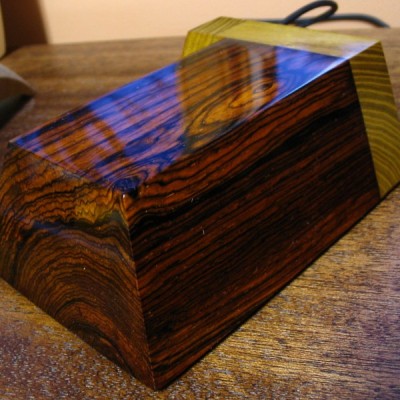
Can you see the end-grain?
Manufactured wood such as MDF, OSB, and particleboard all have a distinct look that is—in nearly all cases—easily distinguishable from the endgrain of real wood. Look for growth rings—formed by the yearly growth of a tree—which will be a dead-giveaway that the wood sample in question is a solid, genuine chunk of wood taken from a tree.
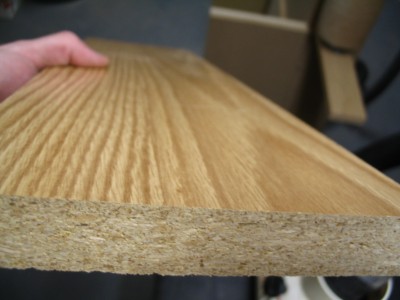
Is it veneered?
If you see a large panel that has a repeating grain pattern, it may be a veneer. In such cases, a very thin layer of real wood is peeled from a tree and attached to a substrate; sometimes the veneer can be one continuous repeating piece because it is rotary-sliced to shave off the veneer layer as the tree trunk is spun by machines. Assuming it is a real wood veneer with a distinct grain and texture—and not merely a piece of printed plastic—you may still be able to identify the outer veneer wood in question, but you should still realize that is it only a veneer and not a solid piece of wood.
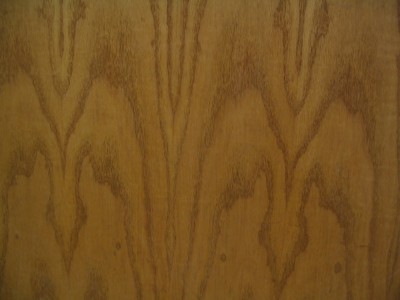
Is it painted or printed to look like wood?
Many times, especially on medium to large-sized flat panels for furniture, a piece of particleboard or MDF is either laminated with a piece of wood-colored plastic, or simply painted to look like wood grain. Many of today’s interior hardwood flooring planks are good examples of these pseudo-wood products: they are essentially a man-made material made of sawdust, glues, resins, and durable plastics.
2. Look at the color.
Some questions to immediately ask yourself:
Is the color of the wood natural, or is it stained?
If there is even a chance that the color isn’t natural, the odds are increased that the entire effort of identifying the wood will be in vain.
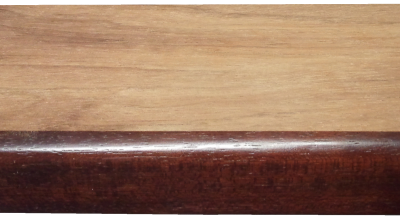
Is it weathered or have a patina?
Many woods, when left outside in the elements, tend to turn a bland gray color. Also, even interior wood also takes on a patina as it ages: some woods get darker, or redder, and some even get lighter or lose their color; but for the most part, wood tends to darken with age.
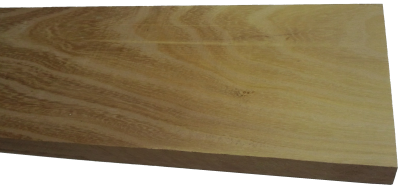
Is it possible to sand or plane the board to see the natural raw color of the wood?
The most predictable baseline to use when identifying wood is in a freshly sanded state. This eliminates the chances of a stain or natural aging skewing the color diagnosis of the wood.
3. Observe the wood grain.
If the wood is unfinished, then look at the texture of the grain. Ask yourself these questions:
Does the wood have an open, porous texture?
Most softwoods will be almost perfectly smooth with no grain indentations, while many common hardwoods have an open pore structure, such as oak or mahogany; though there are some hardwoods that are also smooth to the touch, such as maple.
Can you tell if the wood is quartersawn or plainsawn?
By observing the grain patterns, many times you can tell how the board was cut from the tree. Some wood species have dramatically different grain patterns from plainsawn to quartersawn surfaces. For instance, on their quartersawn surfaces, lacewood has large lace patterns, oak has flecks, and maple has the characteristic “butcher block” appearance.
Is there any figure or unusual characteristics, such as sapwood, curly or wild grain, burl/knots, etc.?
Some species of wood have figure that is much more common than in other species: for example, curly figure is fairly common in soft maple, and the curls are usually well-pronounced and close together. Yet when birch or cherry has a curly grain, it is more often much less pronounced, and the curls are spaced farther apart.
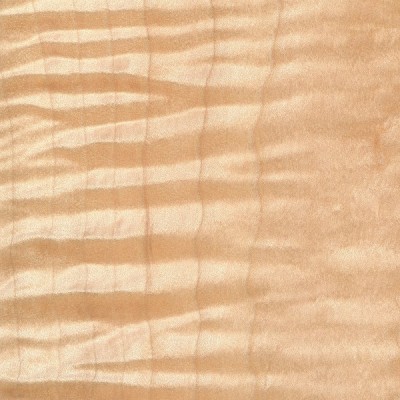
4. Consider the weight and hardness of the wood.
If it’s possible, pick the piece of wood up and get a sense of its weight, and compare it to other known wood species. Try gouging the edge with your fingernail to get a sense of its hardness. If you have a scale, you can take measurements of the length, width, and thickness of the wood, and combine them to find the density of the wood. This can be helpful to compare to other density readings found in the database. When examining the wood in question, compare it to other known wood species, and ask yourself these questions:
Is the wood dry?
Wood from freshly felled trees, or wood that has been stored in an extremely humid environment will have very high moisture contents. In some freshly sawn pieces, moisture could account for over half of the wood’s total weight! Likewise, wood that has been stored in extremely dry conditions of less than 25% relative humidity will most likely feel lighter than average.
How does the wood’s weight compare to other species?
Taking into account the size of the board, how does its weight compare to other benchmark woods? Is it heavier than oak? Is it lighter than pine? Look at the weight numbers for a few wood species that are close to yours, and get a ballpark estimate of its weight.
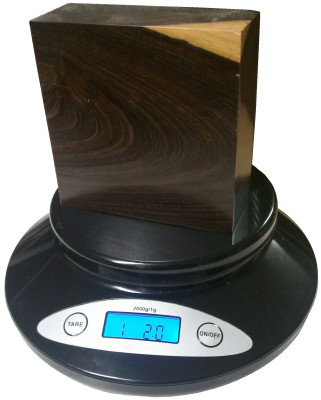
How hard is the wood?
Obviously softwoods will tend to be softer than hardwoods, but try to get a sense of how it compares to other known woods. Density and hardness are closely related, so if the wood is heavy, it will most likely be hard too. If the wood is a part of a finished item that you can’t adequately weigh, you might be able to test the hardness by gouging it in an inconspicuous area. Also, if it is used in a piece of furniture, such as a tabletop, a general idea of its hardness can be assessed by the number and depth of the gouges/dings in the piece given its age and use. A tabletop made of pine will have much deeper dents than a tabletop made of Oak. Additionally, you can always try the “fingernail test” as a rough hardness indicator: find a crisp edge of the wood, and with your fingernail try to push in as hard as you can and see if you’re able to make a dent in the wood.
5. Consider its history.
Many times we forget common sense and logic when attempting to identify wood. If you’ve got a piece of Amish furniture from Pennsylvania, chances are more likely that the wood will be made of something like black walnut or cherry, and not African wenge or jatoba. You might call it “wood profiling,” but sometimes it can pay to be a little prejudiced when it comes to wood identification. Some common-sense questions to ask yourself when trying to identify a piece of wood:
Where did it come from?
Knowing as much as you can about the source of the wood—even the smallest details—can be helpful. If the wood came from a wood pile or a lumber mill where all the pieces were from trees processed locally, then the potential species are immediately limited. If the wood came from a builder of antique furniture, or a boat-builder, or a trim carpenter: each of these occupations will tend to use certain species of woods much more often than others, making a logical guess much simpler.
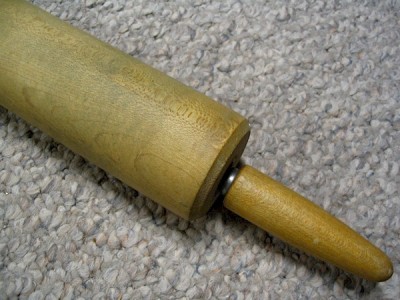
How old is it?
As with the wood’s source, its age will also help in identification purposes. Not only will it help to determine if the wood should have developed a natural patina, but it will also suggest certain species which were more prevalent at different times in history. For instance, many acoustic guitars made before the 1990s have featured Brazilian rosewood backs/sides, yet due to CITES restrictions placed upon that species, East Indian rosewood became a much more common species on newer guitars. (And this is a continuing shift as newer replacements are sought for rosewoods altogether.)
How large is the piece of wood?
Some species of trees are typically very small—some are even considered shrubs—while others get quite large. For instance, if you see a large panel or section of wood that’s entirely black, chances are it’s either painted, dyed, or stained: Gaboon ebony and related species are typically very small and very expensive.
What is the wood’s intended use?
Simply knowing what the wood was intended for—when considered in conjunction with where it came from and how old it is—can give you many clues to help identify it. In some applications, certain wood species are used much more frequently than others, so that you can make an educated guess as to the species of the wood based upon the application where it was used. For instance, in the United States: many older houses with solid hardwood floors have commonly used either red oak or hard maple; many antique furniture pieces have featured quartersawn white oak; many violins have spruce tops; many closet items used aromatic red cedar, and so forth. While it’s not a 100% guarantee, “profiling” the wood in question will help reduce the number of possible suspects, and aid in deducing the correct species.
6. Find the X-Factor.
Sometimes, after all the normal characteristics of a sample have been considered, the identity of the wood in question is still not apparent. In these instances—particularly in situations where a sample has been narrowed down to only a few possible remaining choices—it’s sometimes helpful to bring in specialized tests and other narrower means of identification.
The following techniques and recommendations don’t necessarily have a wide application in initially sorting out wood species and eliminating large swaths of wood species, but will most likely be of use only as a final step in special identification circumstances.
Odor
Believe it or not, freshly machined wood can have a very identifiable scent. When your eyes and hands can’t quite get a definitive answer, sometimes your nose can. Assuming there is no stain, finish, or preservative on or in the wood, quickly sand, saw, or otherwise machine a section of the wood in question, and take a whiff of the aroma.
Although new scents can be very difficult to express in words, many times the scent of an unknown wood may be similar to other known scents. For instance, rosewoods (Dalbergia spp.) are so named for their characteristic odor that is reminiscent of roses. Although difficult to directly communicate, with enough firsthand experience scents can become a memorable and powerful means of wood identification.
Fluorescence
While certain woods can appear basically identical to one another under normal lighting conditions, when exposed to certain wavelengths—such as those found in blacklights—the wood will absorb and emit light in a different (visible) wavelength. This phenomenon is known as fluorescence, and certain woods can be distinguished by the presence or absence of their fluorescent qualities. See the article Fluorescence: A Secret Weapon in Wood Identification for more information.
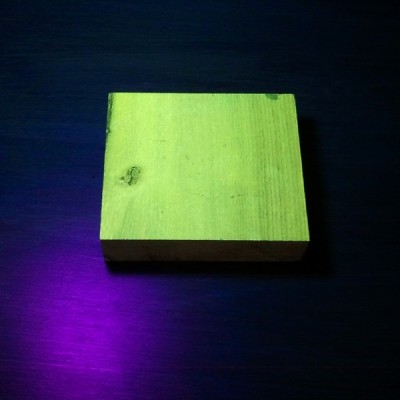
Chemical Testing
There are only a small number of chemical tests regularly used on wood, most of which are very specialized and were developed to help distinguish easily confused species with one another. They work by detecting differences in the composition of heartwood extractives. A chemical substance (called a reagent) is usually dissolved in water and applied to the wood surface: the surface is then observed for any type of chemical reaction (and accompanying color change) that may occur. Two of the most useful are the tests that are meant to separate Red and White Oak, and Red and Hard Maple.
Heartwood Extractives Leachability
Sometimes a wood species will have heartwood extractives that will be readily leachable in water and capable of conspicuously tinting a solution of water a specific color. For instance, the heartwood extractives contained in osage orange (Maclura pomifera) contain a yellowish-brown dye that is soluble in water. (This can sometimes be observed anecdotally when the wood is glued with a water-based adhesive: the glue’s squeeze-out is an unusually vibrant yellow.)
In a simple water extract color test, wood shavings are mixed with water in a vial, test tube, or other suitably small container, and the color of the water is observed after a few minutes. If the heartwood extractives are leachable by water, then a corresponding color change should quickly occur.
In addition to osage orange (Maclura pomifera), merbau (Intsia spp.), and rengas (Gluta spp. and Melanorrhoea spp.) are also noted for their readily leachable heartwood extractives. Because this property is quite uncommon, it can serve to quickly differentiate these woods from other lookalikes.
7. Look at the endgrain.
Perhaps no other technique for accurate identification of wood is as helpful and conclusive as the magnified examination of the endgrain. Frequently, it brings the identification process from a mostly intuitive, unscientific process into a predictable, repeatable, and reliable procedure.
Looking at the endgrain with a magnifier shouldn’t be a mystifying or esoteric art. In many cases, it’s nearly as simple as examining small newsprint under a magnifying glass. There are three components necessary to reap the full benefits contained in the endgrain:
I. A prepared surface.
When working with wood in most capacities, it becomes quickly apparent that endgrain surfaces are not nearly as cooperative or as easily worked as face grain surfaces. However, in this case, it is absolutely critical that a clear and refined endgrain surface is obtained.
For a quick glance of a softwood sample, a very sharp knife or razor blade can be used to take a fresh slice from the endgrain. However, in many denser species, especially in tropical hardwoods, one of the best ways to obtain a clear endgrain view is through diligent sanding. It’s usually best to begin with a relatively smooth saw cut (as from a fine-toothed miter saw blade) and proceed through the grits, starting at around 100, and working up to at least 220 or 320 grit, preferably higher for the cleanest view.
II. The right magnifier.
It need not be expensive, but whatever tool is used to view the endgrain should have adequate magnifying power. In most instances, 10x magnification is ideal, however, anything within the range of 8 to 15x magnification should be suitable for endgrain viewing. (Standard magnifying glasses are typically in the range of 2 to 4x magnification.)
These stronger magnifiers, sometimes called loupes, usually have a smaller viewing area than standard magnifying glasses. Fancier models—with built in lights, or larger viewing surfaces—are available at a premium; but the most basic models are usually only a few dollars.
III. A trained eye.
The third element that constitutes a proper endgrain examination is simply knowing what to look for. In analyzing the patterns, colors, shapes, and spacing of the various anatomical features, there is a veritable storehouse of information within the endgrain—all waiting to be unlocked. Yet, if these elements have not been pointed out and learned, the array of features will simply seem like an unintelligible jumble. The discipline of recognizing anatomical endgrain features is not easily summed up in a few sentences or even a few paragraphs, but it is nonetheless critical to the identification process. To this end, an in-depth look should be given to the various categories, divisions, and elements that constitute endgrain wood identification on the macroscopic level. (In this regard, macroscopic denotes what can be seen with a low-powered, 10x hand lens—without the aid of a microscope—rather than simply what can be seen with the naked eye.) Because the anatomy between softwoods and hardwoods is so divergent, each will be considered and examined separately:Still stumped?
If you have a mysterious piece of wood that you’d like identified, you’ve got a few options for next steps:USDA’s Forest Products Laboratory
You can mail your physical wood samples to the Center for Wood Anatomy Research.
Pros:
- Free
- Professional wood identification
Cons:
- Only available to US citizens
- Slow turnaround times (up to a month or more)
- Limited to three IDs per year
See their Wood ID Factsheet for more info.
Alden Identification Service
You can mail your physical wood samples (even small sections taken from antiques) to Alden Identification Service.
Pros:
- Professional wood identification
- Faster turnaround times (ranging from a few days to a week or two)
Cons:
- Paid service
See their ordering page for more info. (Note that Harry Alden has written several books while at USDA, including both Hardwoods and Softwoods of North America.)
Ask for help online
If the wood ID is merely a curiosity, or non-critical, you can post pictures of the wood in question.
Pros:
- Free
- No need to send physical samples
Cons:
- Greatly limited by the quality of the pictures provided
- Extra work usually required to get adequate clarity in photos
See article of Common US Hardwoods to help find the most commonly used woods.
Get the hard copy
 If you’re interested in getting all that makes The Wood Database unique distilled into a single, real-world resource, there’s the book that’s based on the website—the Amazon.com best-seller, WOOD! Identifying and Using Hundreds of Woods Worldwide. It contains many of the most popular articles found on this website, as well as hundreds of wood profiles—laid out with the same clarity and convenience of the website—packaged in a shop-friendly hardcover book.
If you’re interested in getting all that makes The Wood Database unique distilled into a single, real-world resource, there’s the book that’s based on the website—the Amazon.com best-seller, WOOD! Identifying and Using Hundreds of Woods Worldwide. It contains many of the most popular articles found on this website, as well as hundreds of wood profiles—laid out with the same clarity and convenience of the website—packaged in a shop-friendly hardcover book. 





Why I will no longer be replying to every wood ID request I’ve replied to literally thousands of wood ID requests on this site over the past 13+ years, but as the site’s popularity has grown, so has the time demands for ID on a daily basis. (Contrary to what some may seem to think, I am not some all-knowing wood wizard that can instantly ID your wood. It can actually take me a long time to sift through a lot of different resources.) Over the past few years, my backlog of pending wood species to be added to the… Read more »
Hello, i am struggling to identify this veneer from a chess set from Ukraine. Can you help me perhaps ?
Please attach pics.
Hi there! I am hoping to replace our tiled kitchen floor with hardwoods that match the ones in our living room. The house is a Portland, OR cape cod built in the early 50s. My guess is a lower grade red oak due to the variation or maybe a mix? I’m stumped. Thank you.
Yes, more than likely a species of red oak. It can be very hard to match decades-old flooring even when matching species perfectly. I’ve found the best matches usually come from reclaimed flooring planks from salvage yards sourced locally.
Just had my own question on here so stumbled on yours. I am almost certain it is French oak, i had a floor and library shelving made from reclaimed French oak and it was identical , mine came from an old French barn. Lovely honey colour. The mix was typical of it. As i doubt yours came from France i guess it will be the native oak of France in species. I am struggling to find more of the same for my present house.
Trying to identify the wood in this small wood sculpture, possible Australian
a few people in Perth are reasonably positive that the wood is Wandoo one of the Western Australian hardwoods, obviously a Eucalyptus.
This was increiboy informative . I’ve gone through the entire database and I must admit I feel like I am out of my league. Im trying to identify a carving shown below. Normally I would start with origin and work from there but in this case I’m trying to assess origin from the wood species. It’s a very hard wood, no yield to fingernail. The more I sand the blacker it gets, but it’s dark brown to black in color. Hoping these photos tell you something. Any idea?
I was just going to say ebony, but I think I can faintly make out some interesting grain patterns in the first picture. Such patterns are sometimes called spider-webbing, and they’re most common on rosewoods, such as Brazilian rosewood. And I have definitely seen pieces of Brazilian rosewood get this dark too. But it’s hard to tell without a better look at the endgrain. It could be a rosewood, or maybe something like ziricote, or simply a striped ebony. Can you tell from the style of the carving what continent it might be from?
Eric, I can’t thank you enough for taking the time to respond to me and to others on this post. You are too kind . Based on the carvings it could be asian, possibly Southeast Asian. There are several women depicted with marks on their forehead, but I honestly can’t rule out the possibility that it may be african, or even south american. It was picked up in chinatown in Boston but I know nothing of it’s origin. Looking through the wood identifier database you have here, I also came up with rosewood. Here are some more photos . Again… Read more »
If you can sand a fresh area of the wood, most rosewoods in the Dalbergia genus will have a distinct odor when being worked. Not foolproof, but a way to investigate possibilities. I am not an expert of carving styles, but I would try to investigate carving style and match it up with a continent, which will help dictate species if it does turn out to be rosewood.
Hi Eric,
Can you possibly identify the wood in this old French bed please?
Thank,
Penny
I can’t tell from that pic, sorry.
Hi Eric,
I was wondering if you could tell what type of wood this is?
Trying to figure out if it can be refinished.
It’s a living room floor in a house in Southern Connecticut built in late 1950s.
Thanks.
Best,
Peter
I can’t tell from the pics, but judging from the gaps and narrow planks, it’s almost certainly solid wood, and should be able to be sanded and refinished.
Hello Eric, re: Duncan phyfe style table: sorry for the delay.. here are the pics. I tried to take better pictures with better light. Hoping this will work for you. Thank you kindly Denise
To me, the closest match would be mahogany.
Thank you so much Eric, this was really helpful! Have a great day!!
Kind regards, Denise
Eric,
Thank you, appreciate the response.
Peter
Good morning Eric, We’re selling this 1920 Duncan Phyfe style table and we wanted to know if you could tell us what type of wood this is. We thought maple. It was purchased in Winnipeg Canada at a antique shop and my father was told it was 1920. Thank you so Much!!
I can’t tell much from the photos, sorry.
ok thanks, should I take a closer picture, would that help?
Yes, closer pictures, and in good lighting.
Hello there Eric, I recieved this Vanity from my Grandmother and I am trying to figure out ny information about wood type before I refinish and update it. I am taking a shot in the dark and guessing this piece is around 100 years old. Any info would be helpful. Attached are pictures of the piece, the inside of the drawers. Thank you so very much
Drawer fronts appear to be a ring porous hardwood, so possibly something like ash or oak. I can’t tell too much because the grain is totally obscured by the dark stain, which almost just looks like black paint.
Hi Eric I’ve just purchased this coffee table and was wondering what type of wood it was built from also would it be possible to sand it back and restain it a lighter colour
Many thanks
Neil
As long as it’s solid wood and not veneered, you should be able to sand it back safely. If it’s veneered, you may still be able to sand it back, but you’d have to be very careful not to sand through the veneer layer. I think it’d be much easier to use a chemical stripper first to get most of the finish off, and then sand it down once the bulk of the finish is removed. Much less elbow grease that way.
Do you have any idea what type of wood this is? And if you damaged it in a minor way like small scratches how would you repair it?
It looks like oak, possibly red oak. Since it’s not a natural wood color, but it stained, repairs would be a little less straightforward. Would depend on the depth of the scratches too.
Hello, I have a few lengths of this wood that I cannot figure out what it is. Any good guesses? It’s raw, and freshly wiped down with water. It’s a hard wood with a brown grain similar to wenge
I can’t tell from the pics, but it does appear to be a diffuse porous tropical hardwood with extensive parenchyma (which probably gives it some of its grain pattern). Some species of Albizia or Afzelia spring to mind as possibilities, though tropical hardwoods can be very tricky to ID.
Trying to determine what wood this is. Found in central Maryland in a stream in my backyard, seemingly preserved under the water for a number of years. Small log was about 12-16″ around. I’ve got a couple pictures after cutting it outside. There wasn’t much usable wood so I only have these small blocks you see in the other pictures.
Looks like a species of oak.
Do you have any ideas if it might be red or white/specific species? The pores on the end grained seemed plugged indicating a white oak, but the ray fleks look more like a red oak to me. Any other ideas appreciated!
I’d guess based on age and location you found it, without much rot, that it may be a species of white oak.
Hi Eric, Looking to identify wood trim in a bungalow situated in Australia. I believe the wood is from the late 1910’s possibly 1920s, part of an extension to original 1912 house. Appreciate any guidance you can provide. Cheers
Definitely a softwood species of some sort. I’m not sure if there’s a species native to Australia that is naturally that dark. Otherwise, redwood from the West Coast of the US looks very similar to this picture; for reference, that wood is very soft and lightweight.
Curious as to what type of wood this end table is made of. We have two tables, and they’re quite heavy due to the thickness of wood. Located in Canada and they would have been purchased in the mid-70s. First photo is the underside of the table, second is table surface and 3rd is the back showing the grain pattern of the table top. Debating if I should sell them, or strip them apart, plane and make into something else given that they were my parents. If the second option, any ideas? Thanks!
Please reattach photos, they didn’t come through.
I’ll try again. Looks like it was a file size issue.
Looks like a softwood of some sort, possible Douglas fir. Probably better to repurpose the piece into something else rather than trying to sell it, as it probably wouldn’t fetch much. You could look into making a nice box with it (you could try googling wood boxmaking) or one of my favorites if you have access to a bandsaw and lathe, making a bowl. https://www.wood-database.com/wood-articles/how-to-turn-a-bandsaw-bowl-from-a-board/
Hi there – I am stripping an old door and this is what I uncovered. Any idea what it might be? I am located in the Bay Area of California. There are some splotches and I’m unsure if that’s because theres still stain underneath or if its from UV damage or something since the numbers are still coming through.
Yes, it looks like it’s just not stripped down to bare wood yet. Are you using a chemical stripper for the initial steps? I would highly recommend that over just sanding or strictly mechanical removal of the finish. Looks like a lot of work!
Hi Eric – yes I used a chemical stripper (Citristrip) for the 3 layers of paint and am now sanding off the stain in the more flat areas. I plan to stain using Dark Walnut so I’m hoping that it will stain evenly as I won’t really be able to sand down in the crevices of the panel details. It’s been quite a process but the door is so beautiful and was only $200 at a salvage yard! Otherwise – black door it is!
Any idea on if this is cedar or redwood? It looks like it could be either from your database
Cedar would have a pretty noticeable scent, while the redwood would not. I can’t tell decisively from the pictures, but a lot of times, scent can be a good indicator for different types of cedar species. Also, if you wet with mineral spirits or water, in my experience it tends to darken significantly, more so than most cedar — though this is somewhat subjective.
Hi, could you tell me what wood is on the table top. It was made in England in 1960s. The legs are ebonised wood I think. Many thanks
I can’t tell from the picture, but it appears to be a veneered top of quartersawn hardwood. My guess is African origin. Ovangkol is one possibility.
hello, can you help id what type of wood this guitar is made of? the guitar was made by a custom shop in Chicago in 1992. thanks
https://photos.app.goo.gl/m22CvRrUo9AjD2Zc9
Possibly cherry? Sorry, I can’t tell too much from that photo.
Thank you..
Hello! Any information on this table. Would this be black walnut. The table and sideboard and China cabinet was inherited. I would maybe like to add different legs to update it. Do you think it’s worth it?
Yes, it certainly appears to be solid black walnut for the top. I guess whether you think it’s “worth it” is subjective to a degree. The pieces certainly aren’t junk or cheap, but the design is rather simple. Up to you.
I’d be grateful if you could help identify this wood from an armchair I’m restoring.
Many thanks
Where are you located? Or where did the chair come from?
I’m in the UK. Chair is 2nd hand so unsure as to its origin.
I see a patch of what appears to be reddish brown heartwood. I can’t tell for sure from the pics, but a few woods used in furniture that can sometimes be an imbalanced mix of sapwood and a little heartwood are sissoo and teak.
Indian rosewood. Interesting. Thanks for your help.
Hi, Can anyone tell me if this is real wood and if so… what kind? It’s a crate that a moving company built for a piece of art and I’d like to use it as an outdoor planter for edibles, so i’d like to make sure it won’t leach chemicals. Any help/advice would be appreciated.
Solid wood. Looks like a lightweight softwood such as spruce or fir. Should be safe for your use, though it may be prone to decay if left in contact with exterior moisture.
Thank you so much. Is there something safe i can treat it with to extend its life outside?
I’d use an exterior grade polyurethane or comparable product. Just make sure to coat all surfaces, especially endgrain and surfaces in direct contact with soil.
Hi Eric, how can I make sure this is Jatoba and not something else?
Thank you,
Was this sold to you as jatoba? If so, do you have reason to doubt it? I don’t see anything that would immediately disqualify it as being such. Would need a picture of the endgrain to get a better idea.
We’ve had a heck of time identifying this one…any help at all is greatly appreciated.
Do you know geographically where this wood came from? How heavy is it in comparison to other woods? Any noticeable scent when being worked?
I appreciate your help! It comes from the blue ridge mountains area, it’s a little heaver than the ash and poplar I have, a lot lighter than the cherry. I think the closest wood I have weight wise would be African mahogany maybe. There is zero scent from the wood.
It’s not overly soft or hard…. even one of the guys at our local mill wasn’t sure what it was. ???? It’s been a bit of mystery.
Based on location, I’d guess it is Kentucky coffeetree. Honey locust is another lookalike, but is slightly heavier.
Looking at the descriptions of those two, the Kentucky Coffeetree definitely appears to be the one. I can’t find anything that doesn’t match. (There are a few inconsistencies with the Honey Locust, so I agree, I’m inclined to dismiss that one)
Thank you very much for your help.
Hi Eric. I know pics are tough for you but if you could give it a shot. I’m selling my Dining Room set, chairs and all but I don’t know the type of wood it is…can you tell? I gave a pic of the table and the back of the leaf, hope you can help. It’s very solid and heavy if that helps too. THANK YOU!
I can’t tell from the pics, but I can make out what appears to be large, diffuse porous pattern on the face grain. But I could be mistaken based on limited pic. If I had to narrow it down to only the most common or obvious woods used for furniture, I would at least say there’s a possibility it could be some sort of mahogany. But take that with a grain of salt based on a very limited view.
I have a cabinet made from this wood (I’m pretty sure it has a light brown stain). Unfortunately I can’t see the end grain. Can you identify the wood? It is harder than pine or spruce (a fingernail won’t make an indent). Sorry if this is a duplicate, I couldn’t tell if the picture was uploaded.
Looks like maple or possibly birch.
Hi, could you tell me what species of wood it is, please?
I can’t tell from the pics, but it appears to be a softwood of some sort. So possibly pine, spruce, fir, etc.
Hi Eric, are you able to tell the type off wood on this old table?
I can’t tell from the pictures, sorry. I will say superficially, it does resemble jatoba.
Hello Eric. Can you please help me ID this type of wood used on a vintage magazine rack side table?
I can’t tell from the picture. Looks like a temperate-species diffuse porous hardwood. Possible maple?
This wood is used on for the drawer slide dividers for an oak roll top desk. Probably made in the 1930 to 1950 time period. Need to make 2 to help keep the drawer together so the sides do not spring outward allowing the drawer bottoms to come out of grooves.
Can’t tell for sure from pics, but to me it resembles maple.
Hi Eric, I want to thank you for providing literally thousands of responses to people asking the same question of, “what kind of wood is this?” I, like everyone else, have an unknown wood item. In this case, a dining room table, that I purchased years ago. The person who sold it to me said it was an exotic wood although I cannot recall what he said it was. I thought he said it was Canary wood from Brazil but it’s been years so my memory is fuzzy. Can you give your thoughts on what kind of tabletop this is?… Read more »
I can’t tell from the pics, but it doesn’t look like canarywood to me. It’s possible that seeing a closeup of the endgrain might help. Though it appears to be a diffuse porous tropical hardwood, which can be very difficult to ID, especially over the web.
Hi Eric,
Thank you for the reply.
I’ve snapped a couple of side shots but it sounds like it may be difficult to determine. My wife seems to remember this being Monkeywood (or Monkey Pod wood). Does that sound like a possibility?
Yes, monkeypod would be a much more likely candidate. Certainly more likely than canarywood.
Hello. Can you please id the wood on my Mantel as well as the wooden beams on my ceiling? It’s faded because I’ve been trying to remove the stain that was on it. Thank you in advance!
They all look like softwoods to me. The first pic I can see resin canals, which points to pine. It is probably a species of southern yellow pine.
what kind of wood is this ?
I can’t tell from that pic, sorry.
We are remodeling our house and had cabinets built supposedly out of maple for the bathroom. The issue is the stain is going on very unevenly and almost looks like there’s two different type of wood. One in your opinion in this picture, I feel that the vertical piece of wood looks very different than the horizontal.
It looks like there’s something going wrong with the stain here. For maple, I’d strongly recommend using a gel stain. Usually you’d want to use something like oak if you were staining this dark. Maple is best finished with a water based clear finish for very light colored cabinets.
Hi,
I live in a brownstone in New York City that was built in 1890.
Can you help me identify the wood types for the fireplace mantle and window & door trim?
The mantle originally had a coat of dark varnish which was stripped using “Citristrip”. The window trim had several coats of white paint which was stripped off as well.
What do you recommend I do to refinish each? i.e., wood conditioners, sanding, stain / oil, sealers,… I would like to use a stain or natural oil (Tung, Danish oil,…) for finishing.
Thank you advance!
Mark
The size and frequency of the ray fleck in the second picture looks like sycamore to me. Finishing would greatly depend on look and color that you’re aiming for. Personally, I wouldn’t use a dark colored stain as they’re the hardest to get right, especially when refinishing.
Thanks Eric !! Appreciate your insight. This helps and gives me a good starting point to get the finishing I’m aiming for. Thanks again !!
Identification help please! Thank you in advance!
This is in northern California, probably newer than 2000.
That second pic is beech flooring.
Thanks Eric! TBC the two shots are the same floor from different angles – wanted to show the end grain.
what kind of wood is this????
Those are some pretty extensive rays, which reminds me of some fruitwoods. Any additional information about the wood. Especially presence or absence of odor when being worked.
I turned this wood 1 and a half year ago. and I didn’t smell anything special, there where worms in it. it has a middle rough bark. wood and bark colored purple/pink/red.
Hmm, fruitwoods generally have some sort of odor, so I’m not sure. To me, it still looks most like a fruitwood of some sort. Only other possibility I can think of with rays that big might be a species of Cordia. Or perhaps something more obscure.
I have two 7 foot rope turnings about 5 inches in diameter. The house is in the Tucson AZ area and is 45 years old.
Not sure if that’s spalting, or what those black veins are in the wood. Either way, I can’t tell what type of wood, sorry.
I was given this wood and was wondering what kind it is and if it would be appropriate to use for building an adirondack chair?
I can’t tell from that picture, sorry.
Can you tell me what type of wood this is? 4′ X 8′ South Florida Home Depot I think
Probably birch.
Hello, trying to sell this Entertainment center, and would preferably like something more distinguished to write as the item description instead of the usual. “Cherry Stained wood Entertainment Center in excellent condition”
PLEASE RESPOND ASAP!
Hi, we just pulled up our kitchen flooring and this wood was beneath it. The house was built in 1970 and we live in West Texas. We don’t know what type of wood it is.
Looks like a softwood species, probably southern yellow pine.
Can you give me an idea about my coffee table? I bought it used and my son damaged it and I hope to repair the sent he put in it. Looking to match the color. There is obviously a water stain or something in lower left corner (sorry about the light reflection in upper right, only way to get a decent picture. Besides repairing the giant nick, can i fix the water stain? I tried petroleum jelly with now improvement.
Woods looks to be ring porous or semi-ring porous. Where in the world are you located? That white stain is usually caused by older or poorer quality finishes lacking chemical resistance. Perhaps try wiping the area with a cloth dampened with rubbing alcohol? If it were me, I would lightly sand the entire top of the table with a high grit sandpaper and apply a new, chemical resistance top coat such as polyurethane. The top appears to be veneered, so you’d want to be careful doing too much sanding or refinishing as the veneer can be quite easy to go… Read more »
Trying to identify the type of oak in my floor, as I want to change out some carpet in adjacent rooms and would like to match. I think this cross section looks like red? Not sure if you need a larger cross section but this was pretty loose in the corner of a closet and was easy to obtain. Thanks
Looks like red oak to me, at least assuming that the pores do not contain tyloses, which is hard to tell because of the rough-sawn nature of the endgrain in these pics.
Hi Eric,
Just curious on the type of wood I have here. Was give this wood for free by someone cleaning out a storage unit. Is it hard enough wood to make a charcuterie board out of? Let me know.
I can’t tell ID from pics, but you could just do a general fingernail test on the edge of the board and see if the wood can be indented with your finger. That’s a good way to get a general sense of its hardness and suitability.
Trying to figure out type to replace 10 square
2 1/4 by 3/4
Please attach pics that are in focus.
Can you help identify this tree, please. I got a couple chunks of log out of it. Not sure if the pictures are coming through.
Please attach pics.
Hi there! I’ve been (naively) stripping my Victorian staircase and curious about the wood under the many layers of paint. This is a UK terraced house built in 1896. Can you identify the type of wood? I used a flash to get a better representation of the colour. Hopefully this is accurate. Can you help?
Looks like a softwood. I’m not sure what softwood species would’ve been common in UK in the 1890s, so I can’t comment on exact wood type.
Hello! I purchased this older wood table from a thrift store to refinish. I’m still pretty new to this so any help would be much appreciated. I haven’t gotten all the old brown finish off yet so some of it is coloring the pores brownish. I’ve done some research and I think that it may be maple or oak but I’m unsure.
Can you identify this wood for me?
Please attach pics.
Apologies, they didn’t post the first time because the file was too large.
Looks like rubberwood. https://www.wood-database.com/rubberwood/
Hi Eric, very interesting article with a lot of useful details. Could you please see the photo attached? The darker plank is oak, the other plank weighs less and of lighter colour. Do you believe it is different species? The planks are the same size. Thank you.
They both look like oak to me. There can be a lot of variation in color (and sometimes weight, depending on the age of the tree) in oak.
Hello! Our house, in suburban MD, was built in 1939 and we are undergoing a major renovation. During the demo, we found out that these varied width wood floors ended at the back of the coat closet, which was passed through, to put the 1950s addition on the rear of the house. We don’t know whether to assume these floors are original to the home (we saw another home in our neighborhood listed for sale recently, built-in 1940, with the same floors throughout the home) or a product of one of the several renovations the home went through over the… Read more »
Please attach pics.
So sorry! I thought that I had. Still having trouble but here is a LINK to the images. Many thanks to you!
Hmm, it looks uncommon, at least as far as flooring species in the NE go. The usual suspects are oak, maple, and pine, but this appears to be none of those. However, I think if you could get a clean cross cut of the end of one of those planks, and post a close up picture of the endgrain, we might have a better chance at an ID.